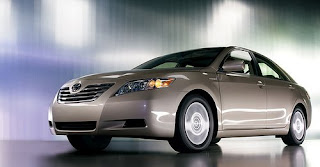 Toyota Camry 2009
Toyota Camry 2009 Buying a hybrid car may give you the bragging rights of being the first person in your neighborhood to drive a hybrid vehicle. But that does not end there. Harnessing the hybrid technology can actually give you several benefits you cannot expect from a conventional gasoline-engine car. 1. Fuel economy. Depending on the driving condition and driver's habits, a gasoline powered family sedan can run 15-34 miles on a gallon of fuel. Hybrid cars, on the other hand can run 40-60% longer at 20- 60 miles on a gallon of gas. This is perhaps the biggest reason why hybrid cars are so popular today. And with the uncontrollable increase in pump prices, hybrid cars can solve at least one of the obvious problems. 2. Durability. The hybrid vehicle automatically shuts off its combustion engine when idling. Not only does it help to conserve gas, it also reduces the wear on the engine. Also, the regenerative braking system that recaptures the lost energy when braking reduces the wear on the brakes. 3. Tax credit reward. While the sticker price of one hybrid car can set you back several thousands more than its non-hybrid counterpart, you can actually enjoy a tax reward of as much as $3000 depending on what hybrid car you buy. Also, the government imposes several incentives exclusive to hybrid car owners like free parking among others. 4. Environmental impact. Hydrocarbons, nitrogen oxides, carbon monoxide, particulate matter (diesel), and formaldehyde also known as formalin are 5 noxious gases emitted by gasoline- or diesel-powered vehicles. These gases contribute to the greenhouse effect. In short, these gases are harmful to the environment. Since hybrid cars consume less fuel, they also emit less fumes. 5. Sophisticated design. If you only care about the looks of the car, then choose among one of the available hybrid cars on the market today and you'll surely fall in love with one of them. Hybrid cars are among the best looking cars today. 6. Exclusivity. There are only a few hybrids among 200 million cars on the road today. And if you own one, then you'll feel that you own an exotic car. While this won't last long since many car manufacturers have announced more hybrid car models in the future plus more and more hybrids are being sold everyday, it is still a good feeling that you are one of the first.
 Toyota Camry 2009
Toyota Camry 2009 Buying a hybrid car may give you the bragging rights of being the first person in your neighborhood to drive a hybrid vehicle. But that does not end there. Harnessing the hybrid technology can actually give you several benefits you cannot expect from a conventional gasoline-engine car. 1. Fuel economy. Depending on the driving condition and driver's habits, a gasoline powered family sedan can run 15-34 miles on a gallon of fuel. Hybrid cars, on the other hand can run 40-60% longer at 20- 60 miles on a gallon of gas. This is perhaps the biggest reason why hybrid cars are so popular today. And with the uncontrollable increase in pump prices, hybrid cars can solve at least one of the obvious problems. 2. Durability. The hybrid vehicle automatically shuts off its combustion engine when idling. Not only does it help to conserve gas, it also reduces the wear on the engine. Also, the regenerative braking system that recaptures the lost energy when braking reduces the wear on the brakes. 3. Tax credit reward. While the sticker price of one hybrid car can set you back several thousands more than its non-hybrid counterpart, you can actually enjoy a tax reward of as much as $3000 depending on what hybrid car you buy. Also, the government imposes several incentives exclusive to hybrid car owners like free parking among others. 4. Environmental impact. Hydrocarbons, nitrogen oxides, carbon monoxide, particulate matter (diesel), and formaldehyde also known as formalin are 5 noxious gases emitted by gasoline- or diesel-powered vehicles. These gases contribute to the greenhouse effect. In short, these gases are harmful to the environment. Since hybrid cars consume less fuel, they also emit less fumes. 5. Sophisticated design. If you only care about the looks of the car, then choose among one of the available hybrid cars on the market today and you'll surely fall in love with one of them. Hybrid cars are among the best looking cars today. 6. Exclusivity. There are only a few hybrids among 200 million cars on the road today. And if you own one, then you'll feel that you own an exotic car. While this won't last long since many car manufacturers have announced more hybrid car models in the future plus more and more hybrids are being sold everyday, it is still a good feeling that you are one of the first.








